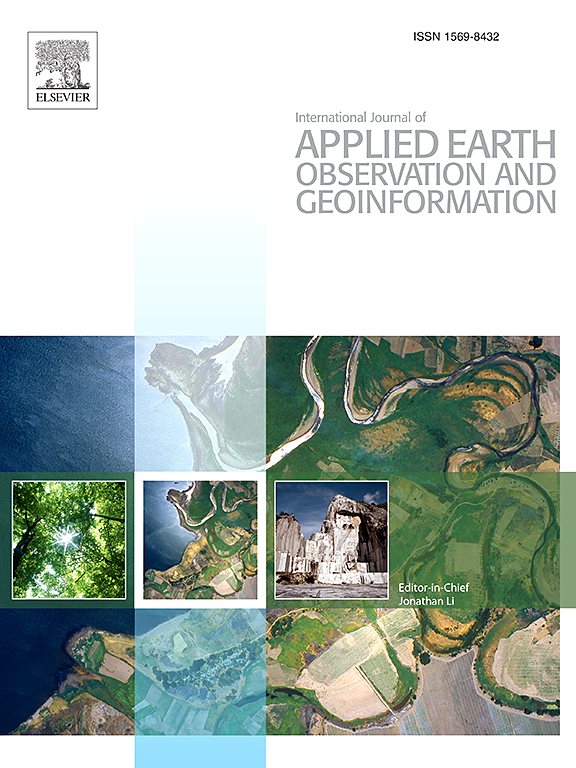Extraction buildings from very high-resolution images with asymmetric siamese multitask networks and adversarial edge learning
IF 7.5
1区 地球科学
Q1 Earth and Planetary Sciences
International Journal of Applied Earth Observation and Geoinformation
Pub Date : 2025-01-07
DOI:10.1016/j.jag.2024.104349
引用次数: 0
Abstract
Building extraction from very high-resolution remote-sensing images still faces two main issues: (1) small buildings are severely omitted and the extracted building shapes have a low consistency with ground truths. (2) supervised deep-learning methods have poor performance in few-shot scenarios, limiting the practical application of these methods. To address the first issue, we propose an asymmetric Siamese multitask network integrating adversarial edge learning called ASMBR-Net for building extraction. It contains an efficient asymmetric Siamese feature extractor comprising pre-trained backbones of convolutional neural networks and Transformers under pre-training and fine-tuning paradigms. This extractor balances the local and global feature representation and reduces training costs. Adversarial edge-learning technology automatically integrates edge constraints and strengthens the modeling ability of small and complex building-shaped patterns. Aiming to overcome the second issue, we introduce a self-training framework and design an instance transfer strategy to generate reliable pseudo-samples. We examined the proposed method on the WHU and Massachusetts (MA) datasets and a self-constructed Dongying (DY) dataset, comparing it with state-of-the-art methods. The experimental results show that our method achieves the highest F1-score of 96.06%, 86.90%, and 84.98% on the WHU, MA, and DY datasets, respectively. Ablation experiments further verify the effectiveness of the proposed method. The code is available at:利用不对称连体多任务网络和对抗边缘学习从高分辨率图像中提取建筑物
从极高分辨率遥感图像中提取建筑物仍然面临两个主要问题:(1)小型建筑物被严重遗漏,提取的建筑物形状与地面实况的一致性较低。(2) 有监督的深度学习方法在少镜头场景下性能较差,限制了这些方法的实际应用。针对第一个问题,我们提出了一种集成对抗边缘学习的非对称连体多任务网络,称为 ASMBR-Net,用于建筑物提取。它包含一个高效的非对称连体特征提取器,由预先训练的卷积神经网络骨干和预训练和微调范式下的变形器组成。这种提取器平衡了局部和全局特征表示,降低了训练成本。对抗边缘学习技术可自动整合边缘约束,增强对小型和复杂建筑形态的建模能力。为了克服第二个问题,我们引入了一个自我训练框架,并设计了一种实例转移策略来生成可靠的伪样本。我们在 WHU 和 Massachusetts(MA)数据集以及自建的东营(DY)数据集上检验了所提出的方法,并将其与最先进的方法进行了比较。实验结果表明,我们的方法在 WHU、MA 和 DY 数据集上分别取得了 96.06%、86.90% 和 84.98% 的最高 F1 分数。消融实验进一步验证了所提方法的有效性。代码见: https://github.com/liuxuanguang/ASMBR-Net
本文章由计算机程序翻译,如有差异,请以英文原文为准。
求助全文
约1分钟内获得全文
求助全文
来源期刊
CiteScore
10.20
自引率
8.00%
发文量
49
审稿时长
7.2 months
期刊介绍:
The International Journal of Applied Earth Observation and Geoinformation publishes original papers that utilize earth observation data for natural resource and environmental inventory and management. These data primarily originate from remote sensing platforms, including satellites and aircraft, supplemented by surface and subsurface measurements. Addressing natural resources such as forests, agricultural land, soils, and water, as well as environmental concerns like biodiversity, land degradation, and hazards, the journal explores conceptual and data-driven approaches. It covers geoinformation themes like capturing, databasing, visualization, interpretation, data quality, and spatial uncertainty.

 求助内容:
求助内容: 应助结果提醒方式:
应助结果提醒方式:


